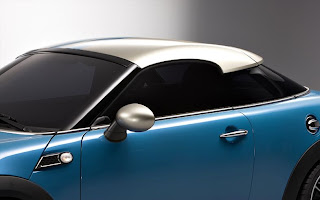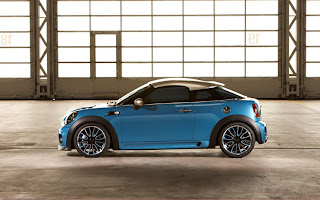More than a decade ago, before the Mini brand made its triumphant return under BMW stewardship, the then Rover Group (also BMW-owned at the time) showed what was in essence the first new-generation Mini concept -- a bulging, retro-styled coupe called the Mini ACV30 which was created to celebrate the 30th anniversary of Mini's win at the 1967 Monte Carlo Rally. Now, as Mini begins celebrating its 50th anniversary, it's taking another crack at the body style.
While the Mini Coupe Concept may not share the ACV30's dramatic bulging fenders and mid-engine layout, it reflects elements of the original's sloping roofline and race-inspired design. Starting with a standard Mini Cooper with the JCW package, engineers tossed out the rear seats and the C-pillars and reworked the Mini's signature boxy hatchback into a sleek fastback. To give the Coupe a sportier appearance, the windshield and A-pillars are raked back several degrees -- lowering the car's height by two inches over the Cooper.
In classic Mini fashion, the roof is a different color from the rest of the car and, in this case, it sets off the new body style much more than on a standard Mini Cooper. The drastic color change draws attention to the tops of the B-pillars, which have been tucked under the roof, making it look almost like a bottle cap on the top of the car. More than just a change in paint color, the line that starts at the back of the side windows wraps around the rear of the car over the tops of the rear window and forms an integrated rear spoiler at the back of the roof. The whole roof piece is aluminum rather than steel to reduce weight and lower the car's center of gravity for better handling and performance.
Below it, the wraparound rear window slopes back to the tail of the car where it dissolves into a faux trunklid. In actuality, the rear glass and trunklid are part of a single, integrated liftgate that provides access to the cargo area behind the seats. With the rear seats gone, cargo space is 8.8 cubic feet, three more cubes than a standard Mini Cooper with its rear seats up but nowhere near the 24 cubic feet of space available in a standard Cooper with its rear seats folded down. A pass-through between the front seats allows easy access to the cargo area from inside the car.
While the new roof is the primary feature on the Mini Coupe Concept, it isn't the only change. Up front, lower fascia has been restyled, featuring large, aggressive brake ducts around the foglights and a new lip spoiler. Up higher, the standard honeycomb grille is replaced by three horizontal slats that match the body color and the twin stripes running up the center of the car, which cleverly switch to the opposite color when passing from the blue body to the gold roof and vice versa. Mini has added small scoops in the side skirts and new multispoke wheels painted in blue and black to match the body colors.
Under the hood, not as much has changed. The Mini Coupe Concept is powered by the same 1.6-liter turbocharged four-cylinder in the Mini Cooper JCW, but with output increased slightly to 211 horsepower. Torque remains the same at 192 pound-feet, but can be temporarily pumped up to 206 pound-feet by the overboost feature.
As with the engine compartment, the passenger compartment is also mostly unchanged. The oversized speedometer with embedded audio and navigation systems still occupies the center of the dash while the tachometer resides directly behind the steering wheel, but it's no longer alone. The tachometer is now flanked by two Chronoswiss clocks, one a stopwatch for tracking lap times and the other a standard analog clock. The interior is finished in black with carbon-fiber trim.
The analytical among you may point out that this concept is essentially a hardtop Mini Cooper that's been slightly restyled, and you'd be right. Other than the height, the Mini Coupe Concept's dimensions are exactly the same as those of the production hardtop. Mini does promise, though, the changes to the roof structure and the lack of rear seats have lowered curb weight and center of gravity. Combined with the slight increase in power and sleeker greenhouse, the Coupe Concept is expected to perform slightly better than its Cooper sibling and provide a smidge more efficiency in the process.
The real beauty of the design, though, is that it would be very easy to adapt into production due to the relative lack of changes. Whether the Mini Coupe Concept actually does make it to showrooms or whether it is a hair split too thin remains to be seen. The final decision will no doubt be affected by the concept's reception at the Frankfurt motor show next month. Stay tuned to MotorTrend.com for complete coverage of the 2009 Frankfurt show on Sept. 15 and 16.
While the Mini Coupe Concept may not share the ACV30's dramatic bulging fenders and mid-engine layout, it reflects elements of the original's sloping roofline and race-inspired design. Starting with a standard Mini Cooper with the JCW package, engineers tossed out the rear seats and the C-pillars and reworked the Mini's signature boxy hatchback into a sleek fastback. To give the Coupe a sportier appearance, the windshield and A-pillars are raked back several degrees -- lowering the car's height by two inches over the Cooper.
In classic Mini fashion, the roof is a different color from the rest of the car and, in this case, it sets off the new body style much more than on a standard Mini Cooper. The drastic color change draws attention to the tops of the B-pillars, which have been tucked under the roof, making it look almost like a bottle cap on the top of the car. More than just a change in paint color, the line that starts at the back of the side windows wraps around the rear of the car over the tops of the rear window and forms an integrated rear spoiler at the back of the roof. The whole roof piece is aluminum rather than steel to reduce weight and lower the car's center of gravity for better handling and performance.
Below it, the wraparound rear window slopes back to the tail of the car where it dissolves into a faux trunklid. In actuality, the rear glass and trunklid are part of a single, integrated liftgate that provides access to the cargo area behind the seats. With the rear seats gone, cargo space is 8.8 cubic feet, three more cubes than a standard Mini Cooper with its rear seats up but nowhere near the 24 cubic feet of space available in a standard Cooper with its rear seats folded down. A pass-through between the front seats allows easy access to the cargo area from inside the car.
While the new roof is the primary feature on the Mini Coupe Concept, it isn't the only change. Up front, lower fascia has been restyled, featuring large, aggressive brake ducts around the foglights and a new lip spoiler. Up higher, the standard honeycomb grille is replaced by three horizontal slats that match the body color and the twin stripes running up the center of the car, which cleverly switch to the opposite color when passing from the blue body to the gold roof and vice versa. Mini has added small scoops in the side skirts and new multispoke wheels painted in blue and black to match the body colors.
Under the hood, not as much has changed. The Mini Coupe Concept is powered by the same 1.6-liter turbocharged four-cylinder in the Mini Cooper JCW, but with output increased slightly to 211 horsepower. Torque remains the same at 192 pound-feet, but can be temporarily pumped up to 206 pound-feet by the overboost feature.
As with the engine compartment, the passenger compartment is also mostly unchanged. The oversized speedometer with embedded audio and navigation systems still occupies the center of the dash while the tachometer resides directly behind the steering wheel, but it's no longer alone. The tachometer is now flanked by two Chronoswiss clocks, one a stopwatch for tracking lap times and the other a standard analog clock. The interior is finished in black with carbon-fiber trim.
The analytical among you may point out that this concept is essentially a hardtop Mini Cooper that's been slightly restyled, and you'd be right. Other than the height, the Mini Coupe Concept's dimensions are exactly the same as those of the production hardtop. Mini does promise, though, the changes to the roof structure and the lack of rear seats have lowered curb weight and center of gravity. Combined with the slight increase in power and sleeker greenhouse, the Coupe Concept is expected to perform slightly better than its Cooper sibling and provide a smidge more efficiency in the process.
The real beauty of the design, though, is that it would be very easy to adapt into production due to the relative lack of changes. Whether the Mini Coupe Concept actually does make it to showrooms or whether it is a hair split too thin remains to be seen. The final decision will no doubt be affected by the concept's reception at the Frankfurt motor show next month. Stay tuned to MotorTrend.com for complete coverage of the 2009 Frankfurt show on Sept. 15 and 16.
 |
| Mini Coupe Concept |
Mini Coupe Concept
Mini Coupe Concept
Mini Coupe Concept





































No comments:
Post a Comment